Overview
Kashmir, the land of alpine lakes, picturesque gardens, rolling meadows, towering mountain ranges, rich wildlife and cultural heritage is no less than a heaven on earth. It is located in the northernmost geographical region of India and is known for its untouched natural beauty. It has several paradises in the lap of nature and Kashmir Great Lakes Trek (KGL Trek) is one of them.
The topography of Kashmir is mostly mountainous, which is beautiful yet challenging. In the Vale of Kashmir, several freshwater lakes exist naturally. Most of these lakes of Kashmir are nestled in the heart of the valley and they are enveloped by dense forests. Due to being in an outdoor region, the only way to reach the lakes is by hiking over the trail.
Out of many, the Kashmir Great Lakes Trek, famous for more than seven lakes on its trail, is the most beautiful trek in India. The nature lovers who want to explore these lakes and experience the magic of trekking in Kashmir, they have to commence on the adventure of hiking amidst the elements of nature, meadows, forests, and river streams. Let us delve into this beautiful trek and know everything in detail.
Situated in Central Kashmir Valley of Ganderbal district, the trek is one of the most enthralling treks in India. It opens the window to get closer to nature’s untouched wonders.
The trek begins from Shitkadi Campsite, at a scenic hill station of Sonamarg. Due to being located in the picturesque region of Kashmir Valley, it will stun you with charismatic views of surrounding mountain ranges like Karakoram, shimmering river streams, mirror-like alpine lakes, high-altitude passes, and velvety meadows.
As a true monsoon trek, it extends the wonderful opportunity to stare at the colourful monsoon beauty of the Great Himalayas. This alpine wonderland is at 77 KM distance from Srinagar city. Surrounded by the Peaks of the Great Himalayas and the Pir Panjal Range, this trek is ideally near the Sonamarg, northeast of Srinagar.
As the name expresses, this pristine trek takes you to the lap of the Himalayas, where more than seven unreal, awe-inspiring alpine lakes are present naturally. The most popular lakes among them are Vishanshar, Krishansar, Gadsar, Gangabal, Nundkol and Satsar. The people who live in hamlets in close vicinity of these lakes live their life with a basic lifestyle. They are mainly engaged in the primary sector such as agriculture, cattle rearing, and horticulture. That’s why you will see some shepherd huts and cattle on your trek route. Moreover, the culture that they follow is mostly Hinduism and Buddhism.
For the nature photography geeks, this trek is a walking paradise, as it extends the opportunity to capture the beautiful sunset behind the rugged mountains, landscape views of the lake, river, forest, and mountain in a single frame, camping experience under the star-filled sky, and outdoor life full of wildlife. Moreover, this trek is a perfect hiking adventure for individuals with a wanderlust soul.
Kashmir Great Lakes also known as Sonamarg-Vishansar-Naranag Trek is a 74 KM trek, with elevation ranging from 7,200 ft – 13,800 ft. The trek is rated as a moderate to difficult trek as we have to walk 7-9 hours each day, cross three passes (Nichinai Pass, Gadsar Pass, Zaj Pass), walk ascents and descents. The trail from Shitkari to Great Lakes includes views of denuded hills, vast meadows, around six glacial lakes, more than five different valleys, and vibrant blooming flowers. Apart from all these, the most goosebumps-giving experience would be the closer views of high altitude lakes.
You will be dazzled after witnessing the reflections of mountains in the lake. Moreover, during monsoon season, you will observe the icebergs floating on the lakes.
Additionally, there will be yellow and blue coloured wildflowers, streams and rocky terrains around the lake. It would appear like postcard-perfect views. If you head on this trek of Kashmir, then each day is a pleasant experience with thrill of crossing many small rivers and water streams, hiking through high-altitude passes, panoramic vistas, and ever changing landscape.
Looking at its high-altitude, trek length, long walking days, challenging mountain passes, steep ascents and descents, unpredictable weather, trail with a lot of boulders and varying range of landscape, the trek comes in the category of moderate-difficult trek.
Hence, it’s an ideal trek for people with good physical fitness and prior experience in high-altitude treks. If you are a beginner, it might be risky to go on this monsoon trek.
Highlights of the KGL Trek-
- This trek is one of the few top destinations in India that look most ravishing and outstanding in the peak Monsoon Season.
- If you embark on this prettiest trek, then you can get the benefit of visualising more than seven lakes of Kashmir in a Single Go.
- Moreover, the trails of this trek offer you beautiful views of more than five vast rolling meadows bursting with alpine herbs.
- On this adventurous trek to the great lakes, you will cross through three high-altitude passes located at approximately 13000 ft.
- Zaj Pass, the last pass of this trek will amaze you with views of Mount Harmukh, Gangbal and Nundkol Lakes and many other Himalayan ranges.
- After every 5 KM on this trek, your eyes will catch glimpses of valleys with Blooming Flowers. In addition, the different bees and butterflies keep revolving around these nectar-filled flowering plants.
- Last but not least, you will get to stare at breathtaking panoramic mountain views from elevated points of this trek.
This was the brief about Kashmir Great Lakes Trek, let us move ahead a
Kashmir Great Lakes Trek Itinerary
Day 1: Drive from Srinagar to Shitkadi Campsite
Drive Distance: 80 km
Drive Time: 3-4 hrs
Altitude: 9,000 ft (2,743 m) at Shitkadi Campsite
Day 1 of the Kashmir Great Lakes Trek will begin with the scenic drive from Nishant Garden Srinagar to Shitkadi Campsite. Shitkadi Camp is at about 80 KM distance from Srinagar, so you will reach there after 3 hours of driving via the tranquil meadows of Sonamarg. From Sonamarg, the Shitkadi Camp is only 5.5 KM distance. After reaching Shitkadi, we shall set our camps there and will spend the night in this camp under the clear sky.
Trek Distance & Time: 8.6 KM, 4-5 hrs
Altitude: 11608 ft (3,538 m) at Nichinai Campsite
Difficulty Grade of The Day: Moderate
Highlights of The Day: Nichinai Lake
Shitkadi Camp settled at 2719m altitude is the point from where the trek for the majestic Kashmir Great Lakes commences. As you start hiking over the path, the trail for the next 5 kilometres will gain ascent gradually.
After hiking on the trail for approximately 3 to 4 hours, you will complete a trek of 5 kilometres. Thereafter, you will hike on a downward slope for a few metres and then again, the trail will gain elevation in each metre up to today’s stop, Nichinai Campsite.
Also from that point, the Nichinai Nar stream appears on your right. Overall after 8.6 KM of trekking alongside fragrant meadows and passing via Shekdur, you will arrive at the Nichinai Campsite, positioned at 3538m altitude. But the Nichinai Lake is placed at a comparatively greater altitude of 4050m on the left side of the Nichinai Campsite. So today, you will see the first lake of this trek, Nichinai Lake, and will come again at the Nichinai Campsite for a night stay.
Trekking Distance & Duration: 14 KM, 7-8 hrs
Altitude: 13,579 ft (4,137 m) at Nichinai Pass and 12,132 ft (3,698 m) at Vishansar Lake
Difficulty Grade of The Day: Moderate
Highlights of The Day: Vishansar Lake
On Day 3, you will start hiking on the trail of Nichinai to Vishansar Lake. Initially, for 2 Kilometres, you will trek on the gentle upward slope, and the next 3 kilometres of the trail will be a steep ascent. Once you have hiked over the path for about 4 hours, then a small lake on the 4150m altitude appears on your left. The lake would be surrounded by vibrant flowering plants and herbs. In addition, you can observe a few cattle roaming around the lake.
From there onwards, there is a steep descent for about 2.6 Kilometres and then a gradual descent for the next 6 kilometres. On this stretch of 8.6 kilometres, firstly, after 1.5 kilometres, you will pass through a small glacial lake at an altitude of 4020m and then you will see the two more lakes after the next 1.5 KM of the trail. At that point, you will cross the Raman Nala Stream as well.
Overall after 14 to 15 Kilometres of hiking on the Nichinai to Vishansar Lake trail via Nichinai Pass, you will reach the spiritual cum pristine Vishansar Lake, reflecting the beauty of Kashmir at 3698m altitude. For a nightbreak, we shall set our tents here on the Vishansar campsite in the close vicinity of Vishansar Lake.
Trekking Distance & Duration: 15 KM, 8-9 hrs
Altitude: 13,822 ft ( 4,213 m) at Gadsar Pass and 11,893 ft (3,625 m) at Gadsar Lake
Difficulty Grade of The Day: Moderate to Difficult
Highlights of The Day: Krishansar Lake, Gadsar Pass & Gadsar Lake
On Day 4 of the Great Lakes Trek, you will get to visualise the precious Krishansar and Gadsar Lakes. In the morning, after freshening up and eating breakfast, you will start trekking with the enthusiasm of exploring the alpine lakes of Kashmir.
After you begin hiking, there will be a gradual descent for a few metres and then a smooth ascent for 2 kilometres. After hiking this long distance, you will reach Krishansar Lake. Here, you can spend a few minutes watching the crystal-clear beauty of the lake.
When you hike ahead of Krishansar Lake, there is a steep upward slope for 2 kilometres. And hiking over this 2 KM challenging trail via Gadsar Pass, you will reach the highest point of this Kashmir Great Lakes Trek, residing at 4213m altitude. From this spot, you can gaze at the 360° serene views of rugged mountains, alpine lakes, narrow water streams, bright green meadows and the high altitude vegetation.
Ahead of this point, there is a steep descent for 3 kilometres, which will be challenging as well as sweat-giving. However, after this, you will hike on the easy descent for only 2 Kilometres and will arrive at the Gadsar Lake, situated at 3625m The stunning views of Gadsar Lake, surrounded by radiant flowers and shrubs, will make your hard work worth it.
But, the Gadsar campsite is 5 kilometres ahead, so you will hike on the trail for 3 hours more on the same gradual descent.
On this stretch of 5 KM, the Gadsar Nala Stream will adjoin the trail on your left. As you reach the Gadsar Campsite, we will set up the camps on the ground for a mesmerising night stay amid the raw beauty of the Mountains and alpine lakes.
Trekking Distance & Duration: 13 to 14 KM, 7-8 hrs
Altitude: 12,093 ft ( 3,686 m) at Satsar Lake
Difficulty Grade of The Day: Easy-Moderate
Highlights of The Day: Satsar Lake
On the morning of Day 5, when you will begin hiking on the Gadsar to Satsar trail then there is a descent of 1.3 KM After crossing this 1.3 KM trail, you will start hiking on a zig-zag trail, in which there are a few smooth ascent and descent slopes up to 10 KM Passing through these trails after 7 KM , you will reach the Doobta Pani campsite established at 3594m On its right side, a lovely alpine lake known as Watal Sar is present. This lake is enveloped by daisies and poppy flowers on all sides.
From there onwards, after hiking 3 KM you will reach the Satsar Lake located at 3686m We shall set our camps either at Satsar or Doobta Pani campsite for tonight’s stay..
Trekking Distance & Duration: 11 to 12 KM, 4-8 hrs
Altitude: 11,716 ft (3,571 m) at Gangabal Lake, and 13,276 ft (4,047 m) at Zaj Pass
Difficulty Grade of The Day: Moderate
Highlights of The Day: Gangabal Lake, Nundkol Lake and Zaj Pass
On Day 6, when you will begin heading towards Gang Bal, there will be a 1 KM zig-zag trail. After 1 KM, there will be two Mengan Dob lakes on your left side. From there onwards, there is a steep uphill trek for 4 kilometres. On this route, you will see the Satsaran Nar stream on your left. After ascending this tough 4 KM steep trail via Zaj Pass, which is at an altitude of 13,276 ft above sea level, you will trek down a steep downhill slope for 3 kilometres. Crossing the Patip Pathiran Nar stream and descending over the zig-zag trail, you will reach Gangbal Lake and the campsite.
Out of the several lakes on this trek, Gangbal is the largest lake. Within a few metres, there is another alpine lake, Nundkol, which is also a large and magnificent lake. Crossing the Mungshunga Nala, you will reach Nundkol Lake and the campsite.
Besides this, there are a few more small lakes that are settled in the close vicinity of Gangabal Lake. Those lakes are Kanasar, Andarun, Lolgul Sar and Satnai Sar.
Similar to every day, we shall set our camps on the Gangbal Campsite and will feel the serenity of the surroundings in this secluded region.
Drive Distance: 40 KM, 2-3 hrs
Trekking Distance & Duration: 14 KM , 7-8 hrs
Altitude: 7,415 ft (2260 m) at Naranag
On day 7, we shall be returning from this amazing Kashmir Great Lakes Trek. When you begin trekking, there is a zig-zag descent for 10 KM and then a steep ascent on the last 4 KM trail. After hiking this long distance, you will finally reach Naranag. From Naranag, Srinagar is about 40 KM distant. So you will cover this distance by driving on the Srinagar Leh Highway. On the way, you will pass through Kangan, Palang, Wayil, and the Sind River. Once you reach Srinagar, this trek will come to an end.
Kashmir Great Lakes Trek Package
Price Inclusion
Accommodation: Enjoy comfortable camping during your trek with tent stays offered on a triple sharing basis.
Transport: Transport from Srinagar (TRC/Nishant Garden) to the Sonmarg basecamp and back from Naranag to Srinagar (TRC/Nishant Garden) is included in the package.
Meals: We provide nourishing and delicious vegetarian meals. Our meals are designed to keep you energized throughout the trek.
Trek Equipment: All essential trek equipment is included, such as sleeping bags, kitchen and dining tents, utensils, mattresses, personal tents, toilet tents, and crampons (if needed).
Camping Fees/Permits: All necessary trekking permits and woodland camping fees are included in the package, ensuring a hassle-free experience.
Mules and Porters: Mules and porters are available to carry central equipment like tents, kitchen equipment, etc.
Trek Staff: A qualified, professional team, including a mountaineering-certified trek leader, guide, cook, and support staff, will accompany you.
Emergency Kit: First aid medical kits, oxygen cylinders, and stretchers are provided for safety.
Expert Assistance: You can always reach out to our experts for any queries or assistance during your trekking journey. Simply contact us at +91-8089693825.
Price Exclusion
Meals during transportation are not included.
Accommodation and meals in Srinagar on the last day of the trek are not included.
If you prefer to offload your backpack, an additional fee of INR 500 per bag/ per day applies.
Any expenses arising due to emergencies, delays, or unforeseen situations
The service of mules or porters to carry personal bags is not included and can be arranged at an extra cost
Tips for the trekking team are optional and not included in the package.
5% Goods and Services Tax (GST) is applicable and not included in the package.
Note-
- Pickup and drop-off from Srinagar Airport can be arranged at an additional cost.
- An additional fee of INR 1,500 applies to Non-Indian Nationals for the trekking permit.
- Mandatory documents for the trek permit (to be submitted at least one week before the trek):
- Trek/adventure insurance (we can arrange it for you at an additional cost of INR 600 + 5% GST)
- A medical statement/certificate confirming you are physically fit for basic outdoor activities (it should be approved with doctor’s official stamp)
- Proof of address (Aadhar Card, Driving License, or Passport)
Check the booking procedure here, including details on booking deposits, payment terms, refund and the cancellation policy.
Best Time to Visit Kashmir Great Lakes Trek
The best time to visit the pristine Kashmir Great Lakes Trek is from July to September. During these monsoon months, there is usually a cloudy sky and so precipitation occurs frequently.
When you are trekking in Kashmir, you will be surprised to look at the ever-changing landscape. There is a diversity of landscape in every Kilometer.
At the peak of the monsoon season, the weather is pleasant, as the valley is in full bloom. When you hike over the path, there will be scenery around the trail, and it will look like a picture-perfect landscape. Moreover, the en-route meadows and banks of pristine lakes would be wrapped in lush greenery.
Due to the monsoon season, the flowers and herbs are everywhere in the Kashmir valley, and it looks like a blooming Paradise. This season is the best for trekkers fond of photography and nature lovers. However, during the monsoon season, the humidity is generally high, and sometimes weather conditions are unpredictable.
Besides the Monsoon Season, you can experience the wonder of trekking in Kashmir in the winter season. During winters, there is minimal rainfall, but the temperature drops up to -7°C and the Kashmir Valley receives heavy Snowfall. Therefore, after September, the snowy landscape makes it difficult to walk. So, it is advised to trek in this season only to experienced trekkers, not to beginners.
Moreover, the great lakes of Kashmir as well as small lakes on this trail, are slightly frozen in the peak months of December and January. If you have the desire to witness the white mesmerising beauty of Kashmir, then it looks most picturesque in late December.
As we mentioned above, the best season to commence on the Kashmir Great Lakes Trek is the Monsoon. So here is the in-depth guide for each month during Monsoon Season.
During July, the surroundings of the Kashmir Great Lakes Trek began adorning with flowers. As the precipitation occurs, the leaves turn into a bright green colour, and new saplings come out of the ground. The temperature in July varies from 7°C to 18°C, and the weather is mostly pleasant but humid. There is no such difficulty while trekking this month except for the random rain showers. Therefore, you should keep rain gear along with you on this expedition in July.
In August, the Kashmir Valley transforms into a beautiful flower-filled heaven and the entire trail is encircled with lush greenery. The clouds and frequent rain showers are common, so the temperature varies from 10°C to 20°C. Talking about weather, so due to rainfall, the weather is idyllic and perfect for enjoying the monsoon trek experience.
During the September month, the Kashmir Great Lakes trek receives good precipitation and the weather is mostly cloudy. The temperature in September ranges between 10°C to 22°C, and the nights are colder than the days. If you visit the Great Lakes trek in September, then please carry the rain gear in your backpack. Besides this, in September, you will get to stare at the beauty of Kashmir Valley enveloped by flowers.
Difficulty Level of this Trek
According to the terrain and altitude gain, the trek is undoubtedly a Moderately difficult trek. Its trek route involves steep ascents and descents, as well as high-altitude passes. Therefore, you need to be mentally prepared for long hours of walking. Besides this, the area surrounding the trek of Kashmir Great Lakes has a moderately cold climate but sometimes unpredictable weather conditions in the Monsoon Season.
Considering its rocky trails and great variation in altitude, it is not recommended for first-timers. However, beginners with good physical fitness can plan a hike to these great lakes of Kashmir, but under the guidance of an experienced trekker.
Besides this, if you feel symptoms of Acute Mountain Sickness (AMS), then you must seek medical attention.
Difficulty Analysis with Factors:
The Kashmir Great Lakes Trek is categorised as a difficult trek, so let us peep into the factors that push it into this level of difficulty.
The terrain around the Great Lakes trek is basically the foothill of the Himalayas and so it includes the valleys, alpine lakes, high-altitude passes, rugged trails, dense vegetation and vast meadows. The trail going to the Great Lakes is uneven and includes a steep slope and ascent. Besides this, there are boulders on the trek which make it tough to walk at high speed.
It’s almost impossible to trek on this trail without the rain and trekking gear.
If you hike on this trek, then you need to walk 12 to 15 Km every day, excluding the first and rest days. If you are a beginner, then initially, it will feel doable. But as the two days pass, your energy level drops, and it feels challenging to hike. On the contrary, if you are an experienced trekker, then your strong stamina will push you forward to hike more every day.
If we look at the altitude gain, then the Kashmir Great Lakes Trek begins from Shitkari at 2719m altitude and the highest point of the trek is located at 4213 m altitude.
Besides this, you need to know that this trek is a zig-zag trek. It means, its altitude is not continuously increasing but declining as well. Because the trek slope is uphill and downhill alternatively. The trek stretches with steep climbs is hard to hike in the monsoon season. It can only be managed when you are hiking with the support of a trekking pole and wearing waterproof and high grip trekking shoes.
This enchanting trek of Kashmir is a renowned monsoon trek. Hence, generally the trekkers head on this trail from July to September. Coming to the point, the frequent rain showers make the narrow trails slippery and muddy. This reduces the friction of trails, and so when you hike on slippery trails, you need more force to keep trekking. Besides this, Monsoon comes with unpredictable rain showers, so sometimes it becomes challenging to reach the campsite on time.
Preparation for the Trek [Physical Fitness, AMS]
Treks are all about fun, adventure, finding yourself, etc, but only for those who are mentally and physically fit. Because activities like treks, especially a high altitude Himalayan trek, challenge you on different levels in unimaginable ways and situations.
Below is a quick guide for preparing for this trek-
The trek difficulty dictates your level of fitness and preparations for it. As mentioned above, it is Moderate-Difficult level trek so prepare accordingly.
- Difficult level treks require a good fitness level, where you should focus on building your stamina and strength. Start with walking/running and include a 45-minute to 1-hour workout (cardio + strength training).
- A level-up in a fitness routine is required for a difficult level trek like start aiming to run 5 km in under 20 mins, and strength training is a must.
Mental preparation includes thorough research of the trek you want to do or decide to. Understand the terrain, difficulty level, and the ways to get fit for it, look up for sudden situations that may happen, and how to tackle them. Being prepared gives you an edge to keep calm & handle a difficult situation.
Exercises to achieve the goal
Cardiovascular Training: Running, cycling, and swimming to boost stamina.
Strength Training: Focus on leg exercises like squats, lunges, and step-ups for endurance.
Core Strength: Planks, mountain climbers, and Russian twists to maintain balance on uneven trails.
Flexibility Exercises: Stretching, yoga, and dynamic warm-ups to prevent injuries.
Mental Conditioning: Visualisation techniques, breathing exercises, and meditation to strengthen focus and manage stress on difficult days.
Tip: For moderate to difficult-level treks, practice exercises with weights. Seek professional advice accordingly.
Extra Tips related to the diet, muscle recovery, and healthy lifestyle routine.
Diet: Incorporate proteins like lentils, eggs, paneer, whey protein, etc for fast recovery after a strenuous trek. Whole grains like wheat, barley, etc for sustained energy, and leafy greens like spinach, bitter guard, and any seasonal veggie for those extra nutrients and building the immunity system.
Muscle Recovery: Plan rest days and add stretching, relaxing yoga poses or foam rolling after every workout.
Lifestyle Routine:
- Limit alcohol and caffeine consumption.
- Start sleeping upto 8 hours.
- Stay hydrated – drink 2 to 3 liters of water. To incorporate more nutrients, including coconut water, fruit, and vegetable juices.
Altitude Sickness happens when your body cannot adjust to lower oxygen levels at higher altitudes. This happens mainly because your body doesn’t have enough time to acclimatize to a higher altitude or not enough time to get used to lower oxygen levels.
How to Prevent AMS –
- Gradual Ascent: Climb slowly to give your body time to adjust.
- Hydration: Drink plenty of water to prevent dehydration.
- Rest and Sleep: Ensure ample rest, especially as you reach higher camps.
- Avoid Alcohol: Limit alcohol and caffeine, which can lead to dehydration.
What to do –
- Most Important – Inform your trek leader as well-trained leaders and experience they can assess the situation better and find solutions faster.
What trek leader may suggest? Trekkers without agency should also know these instructions –
- Stop and Rest: Pause your trek to recover.
- Descend if Necessary: Descend immediately to lower campsite, our team with the vehicle and necessary help will be there for further action.
- Stay Hydrated: Drink water and avoid strenuous activity.
- Seek Medical Help: After descending, our team will take you to the nearest hospital if needed. If solo, then descend and seek the closest medical help.
Trek Essentials [What to Pack]
- 45-60 Ltr Bag Pack With Rain Cover & Comfortable Straps
- Hot and Cold Water Bottle Like Borosil and Milton
- Energy Bar, Dry Fruits, and ORS
- Personal Medical Kit
- 1 Pair of Sunglasses (UV Protected)
- 1 Neck Gaiters (Buff)
- Tiffin Box
- 2/3 Full Sleeves (Non-Cotton)
- 1 Full Fleece T-Shirt
- 1 Fleece Jacket (Woolen or Sweater)
- 1 Down Feather/ Hollofil Jacket
- 1 Waterproof Jacket/ Poncho
- 1 Pair of Thermal Inners (Upper and Lower)
- 2 Trek Pants (Avoid Shorts and Denim Pants)
- 1 Pair of Waterproof Gloves
- 1 Pair of Woolen Gloves
- Sun Cap
- Woolen Cap
- 4 Pairs of Cotton Socks
- 1 Pair of Woollen Socks
- 1 Waterproof and High Ankle Trekking Shoes
- 1 Pair of Floaters
- Hand Sanitizer and Sunscreen Lotion
- Toothbrush and Toothpaste
- Toilet Paper
- Quick Dry Towel
- Lip Balm and Antibacterial Powder
- Moisturizer
- Aadhaar Card, Pan, or Passport for Applying Permit
- Trek Insurance
- Medical Certificate
- Self-Declaration Form
- Sleeping Bag
- Common Tent
- Mattress
- Dining Tent
- Camping Stool
- Walkie Talkie (For Team)
- Utensils
How To Reach Base Camp
If you want to reach Srinagar in the fastest mode, then you should choose the flight to travel. There are several flights that fly from Delhi Airport (DEL) to Srinagar Airport (SXR) every day. Firstly, you should come to Delhi from your hometown and then travel to Srinagar by flight. It would be good if you book your Delhi to Srinagar Flight tickets in advance. The flight ticket fare of this route varies from INR 9000 to 13000 per individual in economy class. Generally, the flights on this route take more than a 1-hour layover in Jammu. Besides this, the least time to travel from Delhi to Srinagar by flight is about 4 hours. Moreover, if you are looking for the cheapest flight tickets, then you should prefer booking with Indigo Airlines.
Choosing the train to cover the distance from Delhi to Srinagar is the cheapest way to travel. The individuals who want to reach the Basecamp of the Kashmir Great Lakes trek should first come to Srinagar. The railway stations of Kashmir connected with New Delhi via railway line are Udhampur Railway Station, Katra Railway Station, and Jammu Tawi Railway Station. The distance from these stations to Srinagar is 180 Km, 219 Km, and 247 Km, respectively.
Therefore, you should book the train tickets from Delhi to any of these stations directly. Talking about average train fare from New Delhi to Martyr Captain Tushar Mahajan Railway Station, Udhampur, is INR 338 for Sleeper Class, INR 930 for 3A, INR 1339 for 2A, and INR 2254 for 1A.
When you arrive in Udhampur by train, then you can go to Srinagar by Bus or rental Car.
If you prefer the road journey to travel to Srinagar, then it’s best to book the Bus Seat. A number of AC and Sleeper Buses run between Delhi and Srinagar on a regular basis. The distance from Delhi to Srinagar is about 804 Km, which is a bit more to travel by own car. Therefore, you should book the Bus ticket online through apps like ixigo, RedBus, and so on. The basic fare of a Bus Ticket from Delhi to Srinagar varies between INR 2400 and INR 2800. Moreover, these Buses are equipped with amenities like a Charging Point, a blanket, a Reading light, a water bottle, and an emergency exit.
Once you arrive in Srinagar by the above given modes, then you have to move further to reach the Shitkadi (Sonamarg) base camp of Kashmir Great Lakes Trek.
From Nishant Garden Srinagar, the Shitkadi Campsite is about 77 Km away, and it will take approximately 2 hours to reach there by road. On this route from Srinagar to Sonamarg, several rental cars/cabs/taxis run every hour. On the basis of vehicle type, the fare varies. Generally, the fare ranges from around INR 2000 to INR 3000. Besides this, you can get the Srinagar to Sonamarg transfer under the trek package as well.
When you travel on this route from Srinagar to Shitkadi Campsite, the en-route places are Kangan, Kullan, Sumbal, Chetan and Wayil.
Kashmir Great Lakes Trek Route Map
Here is a quick route map of the trek –
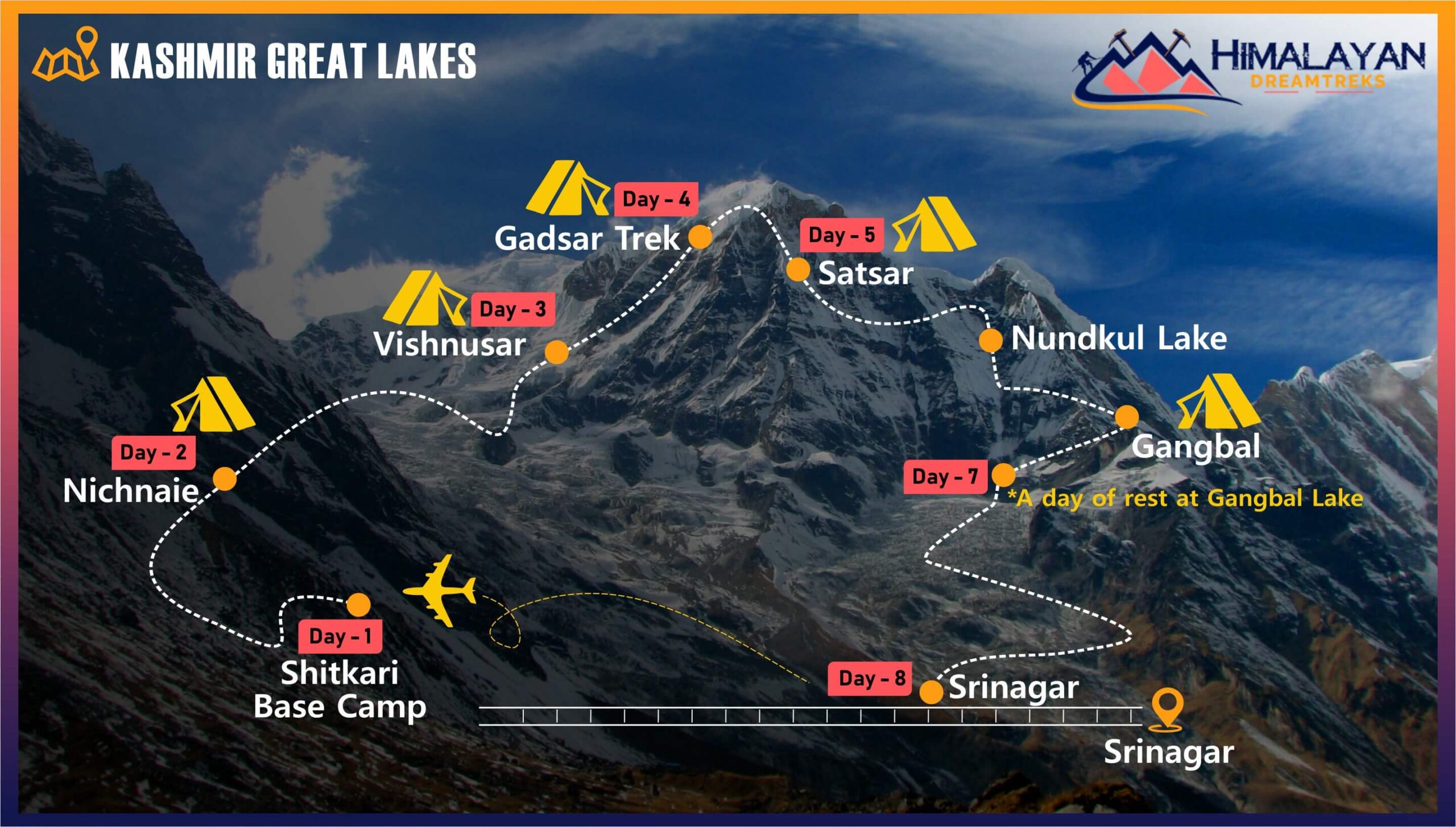
Current Weather & Temperature
Other Facts to Know about the Kashmir Great Lakes Trek
Read more info regarding Kashmir Great Lakes Trek below
Origin of Word “Kashmir”
If we explore the etymology of Kashmir, then it finds its link with a great sage of the Vedic Age, Rishi Kashyap. A popular opinion about the word Kashmir is that it originated from the name of Rishi Kashyap. They say that Rishi Kashyap played the role in making people settle in this beautiful land. Besides this, the Kashyap Mir (lake) and Kashyap Meru (Mountain) are also believed to be connected with the Rishi Kashyap presence in this region.
Vishansar lake:
Cultural significance
Vishansar Lake in Hindi resembles the name of the God Vishnu, who is believed to be the protector and preserver of the world.
Moreover, the Gem of Kashmir Great Lakes Trek, Vishansar Lake, is known as the source of Kishanganga Lake. It is worshipped by the Kashmiri pandits, who are the major population of the region.
Besides this, the local shepherds along with their herds of goats and sheep roam in the meadows of Sonamarg. In the monsoon season, the herbs and shrubs become more juicy and so cattle graze in the meadows for a long.
Additionally, the villagers utilise this area for their cultural and traditional gatherings. The people of these nearby villages are mainly followers of Hinduism and Buddhism.
Historical Background
Vishansar Lake holds spiritual significance for its residents, which was mainly because of its connection with the Hindu deity, Lord Vishnu. This region was mainly used as a meditation center by several sages and saints due to its tranquil nature.
According to the local folklore, there was a woman nearby the area who once suffered from an unknown disease. To cure herself, she soon began her journey to the lake. As she took a dip into the holy water of the lake, she was completely healed. Since then, the spiritual significance of the Vishansar Lake has doubled.
Krishnasar lake:
Cultural significance
Krishnasar Lake has settled in the same vicinity as the Vishansar and is even regarded as its twin. This pristine lake in the Kashmir great lakes trek is devoted to Lord Krishna, who is an incarnation of Lord Vishnu himself.
The villagers of the surrounding hamlets often celebrate auspicious occasions and festivals near this lake as they commonly share great devotion towards it. These old traditional activities have been passed down from generation to generation. Gangabal lake:
Gangabal lake:
Cultural significance
The other sacred lake in the Kashmir Great Lakes trek is the Gangabal Lake, which is known to be the birthplace of the Uttar Ganga River, also known as the Kashmir Ganga.
According to Hindu scriptures, this place is also known as the abode of Lord Shiva and, hence, holds great religious importance for the devotees.
Many trekkers choose this lake as their final destination and visit it to seek the blessings of God.
Following their traditional rituals, Kashmiri Pandits annually organise the Harmukh-Gangabal Yatra to the lake which is largely participated by the devotees.
Historical Background:
In various Hindu texts, this lake has been mentioned mainly in Rajatarangini and Nikanata Purana. Besides this, the people living in nearby villages believe that Gangabal Lake is significant for salvation.
Hence, in that local region, when someone dies, the family members flow their ashes to this lake and pray for the salvation of their ancestors.
Nundkol lake:
Cultural significance
Nundkol Lake is another beautiful and majestic lake in the Kashmir Great Lakes trek. This lake is also called the Nandi Lake. Its name is linked with the Nandi, Vaahan of Lord Shiva.
Pilgrims who undertake the yatra to the Gangabal Lake first perform rituals here and then continue their journey as per their tradition. The villagers believe that the water of the Nundkol lake is pious and hence, they take this to purify their homes.
In the Kashmiri culture, this lake and the entire yatra to the Gangabal Lake hold immense spiritual significance.
Historical Background
There are many tales about Nundkol Lake. The famous one is that the great sage Shilad performed a tough penance near the lake to seek the blessings of Lord Shiva. When Lord Shiva appeared in front of him, Shilad asked him to stay there with him and Lord Shiva couldn’t resist his request. Therefore, he made this place his home, where Shilad gave birth to Nandi Maharaj.
The locals believe that even at present times, both of them reside there and so, they worship the lake and the surroundings as well. Here, they refer to Shiva as the Nandisa, which means the same as Nandi.
Gadsar Lake:
Cultural significance
The Gadsar Lake is a divine lake set amidst the Kashmir Great Lakes trek. Gadsar, in the Kashmiri language, is said to be the lake of fish. This came to be known as Gadsar because of the presence of numerous fishes, including brown trout.
Along with celebrating its spiritual significance, the villagers often share horror tales about the lake as it’s also known by the name “Yemsar”.
Yemsar means the lake of death. However, people still find it very holy and consider its water sacred.
Flora
Kashmir Great Lakes Trek is no less than a paradise for a variety of flowers, herbs, shrubs and trees. When you trek on this trek, you’ll find many unique endemic plants that will definitely catch your attention.
On the sides of the trail, the dense forests of alpine trees like Cider, Fir, oak, pine, and others are present. In the dense region of these forests, wild animals like bears and deer live.
Besides the trees, you will see the vibrant Kashmiri Roses, Himalayan Indigo, tulips, Daffodils, Lilies, Jasmine, Hyacinths, Kashmir Iris, and Marigolds in meadows, valleys, and corners of glacial lakes. These bright-coloured flowers make the entire trail fragrant and full of cheerful vibes.
Fauna
Along with the flora, the Kashmir Great Lakes Trek serves as a home to a wide variety of animals and birds. Around this region, Wagtails, pipits, and rose Finches are commonly seen. Whereas, in wildlife, there are musk deers, Himalayan Black Bear, Himalayan Marmots, Snow Leopards, and others.
Sharada Peetha:
- The Sharada Peeth is located in the Neelum Valley of Kashmir.
- It is believed to be the real home of Goddess Sharada, i.e., Maa Saraswati.
- This site is where the ruins of an ancient Hindu temple and a learning centre are found.
- The architecture of the temple is highly inspired by the Kashmiri style, built using red sandstones.
Amarnath:
- It is one of the most spiritual and mystic Shrines of the Lord Shiva.
- It is situated in the Sind Valley of Kashmir at an elevation of 3,888 m.
- The opening date of the annual Yatra to the Amarnath caves depends on the weather conditions. However, it starts mostly between July and August.
- The Jyotirlinga of Lord Shiva inside the temple is believed to be the Swayambhu.
Dal Lake:
- Dal Lake is one of the major attractions of the Jammu and Kashmir state.
- It’s a freshwater lake that is known worldwide for its picturesque scenery and charismatic houseboats, locally called Shikaras.
- This lake is on the Jhelum River, where you can see numerous water plants, therefore, this is also called the “Lake of Flowers”
- The Dal Lake offers various joyful activities, such as boating, beautiful accommodations, swimming, etc., in its serene location.
- A number of visitors come here every year to witness the unparalleled whispering beauty of its frozen form during winter.
Srinagar City:
- Srinagar is a beautiful city of Kashmir and is also regarded as the summer capital of the state.
- The city is filled with a soothing ambience with the presence of several gardens, houseboats, lakes, and lively markets.
- The best time to visit Srinagar starts from late April to October when the weather is calm and clear to enjoy the views of the Himalayan ranges and the beauty of lakes and gardens.
- As the capital of Jammu & Kashmir, it attracts tourists from distant locations of the world and amazes everyone with its unique, mesmerising beauty.
Vaishno Devi Temple:
- Every year, lakhs of devotees commence on the journey to the temple with faith and devotion for the Goddess.
- Vaishno Devi temple is a sacred Hindu temple devoted to the collective form of Goddesses Mahasaraswati, Mahakali, and Mahalaxmi.
- This highly spiritual temple is located in the Katra city of Jammu and Kashmir on the Trikuta mountain at an altitude of 1500 m.
SCI, Foreign Permit & Vehicle
HDT is registered with the IMF, and we can cater to the needs of SCL for Government Employees. According to the rule, the government of India provides its employees with a prospect where they’re allowed to apply for a 30-day special casual leave in a calendar year to do trekking, hiking, or whatever adventure pleases them.
Mail us at info@himalayandreamtreks.in or call us at +91 80896 93825, if you want to avail SCL.
For foreign nationals, permit charges are different, and hence the overall package price is different for foreign trekkers. Connect with us before booking your trek.
- For 4-6 people Ertiga/Bolero or equivalent vehicle.
- For 7 or more people, Force Traveller.
FAQs
For maximum comfort, we offer three and four person tents with triple-sharing options. Male and female will be staying separately in tents.
During the trek, HDT provides wholesome and nutritional meals. The food is vegetarian and consists of rice, dal, veggies, chapati, paratha, pasta, noodles, and soup. During the trip, we also provide snacks like as biscuits, salty snacks, and dried fruits. Special dietary needs, such as vegan, gluten-free, or Jain meals, can also be accommodated if requested in advance.
The Kashmir Great Lakes Trek (KGL Trek) should not be taken lightly. It is considered a moderate to difficult trek in terms of terrain difficulty. This trek demands long walking over several days spanning approximately 74 km over 7 days. Also, steep ascents and descents, long hours of walking over boulder sections, crossing high-altitude passes over 13,800 feet, altitude sickness, and unpredictable weather are some factors making it such a challenging trek. Its high-altitude and other difficulty features make it more challenging for beginners without prior physical and mental preparation for the trek.
Yes, this trek can be done solo. You should not be too concerned about safety on this trek. A lot of solo travelers do this trek and have had an amazing experience throughout the trek. However, a thoroughly researched trekking company for this trek is a must. Also, be extra careful until you meet your trekking team at the starting point of the trek. From your bus station or airport, book a private taxi or ask us to pick you up from the bus station or airport.
The cost of the Kashmir Great Lakes trek can range from INR 15,000 to INR 25,000 per person, depending on cost factors including the number of people in a group, standard services provided by trekking companies, and optional add-ons included by customers themselves. As a trekking company in India, Himalayan Dream Treks (HDT) provides this trek at INR 20,500/- per person + 5% GST.
This heaven-like adventure and most famous trek in the Kashmir Valley covers a distance of approximately 74 km and takes 7 days to complete the entire trek route (duration can be extended to 8 days with a buffer day for unforeseen weather conditions). Each day varies in length, and on average, it covers around 10–12 km daily for 6 to 7 hours, with some moderately challenging terrain sections.
Yes, the trek is considered safe until you are well-prepared physically, mentally, and with the necessary trail permits for the trek.
This is a high-altitude trek and reaches more than 13,000 feet a total of three times during the trek, which may concern altitude sickness. Also, it has long walking days, challenging terrain, boulder sections, and steep ascents and descents, which require a thoroughly comprehensive fitness plan and an excited mentality about the difficulties you may expect during the trek.
If we talk about security concerns, it is safe from any terrorist activity if you are concerned about the situation in Kashmir. In past years of trekking experience, we have often seen that some trek operators provide fake permits, and when they get caught by the army near the check post, it puts trekkers in trouble for some hours and sometimes leads to trek cancellations. So, always ensure you go on this trek with reputed trekking operators. Otherwise, such a beautiful trek can turn into the worst experience of your life.


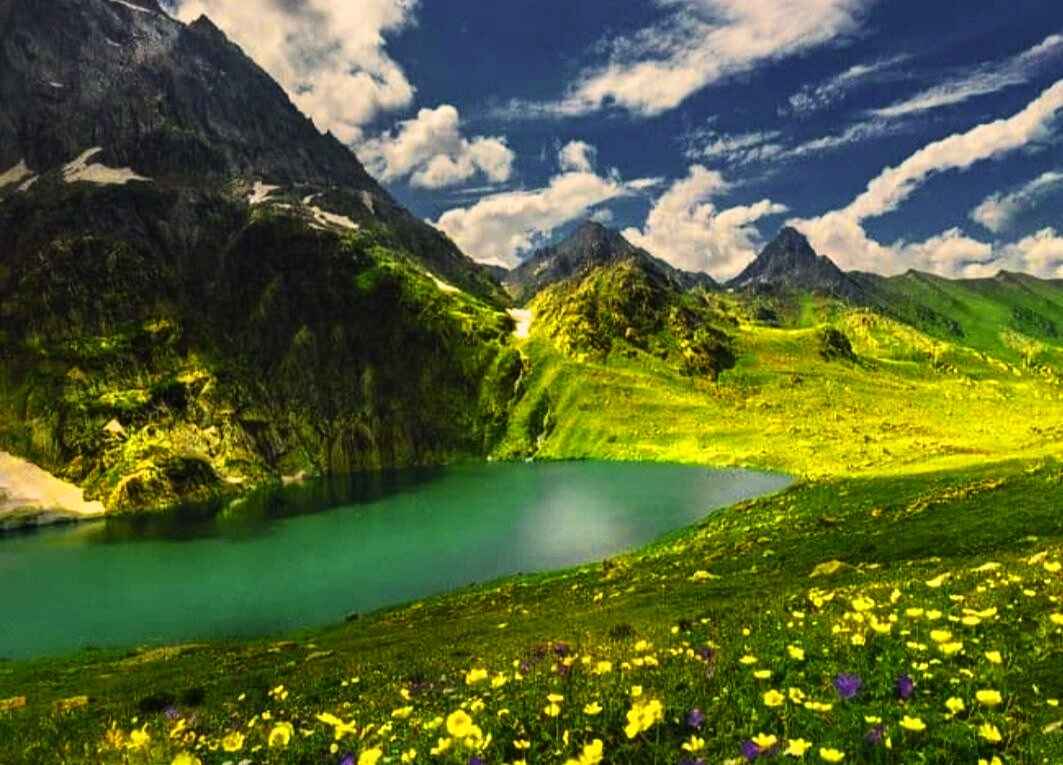
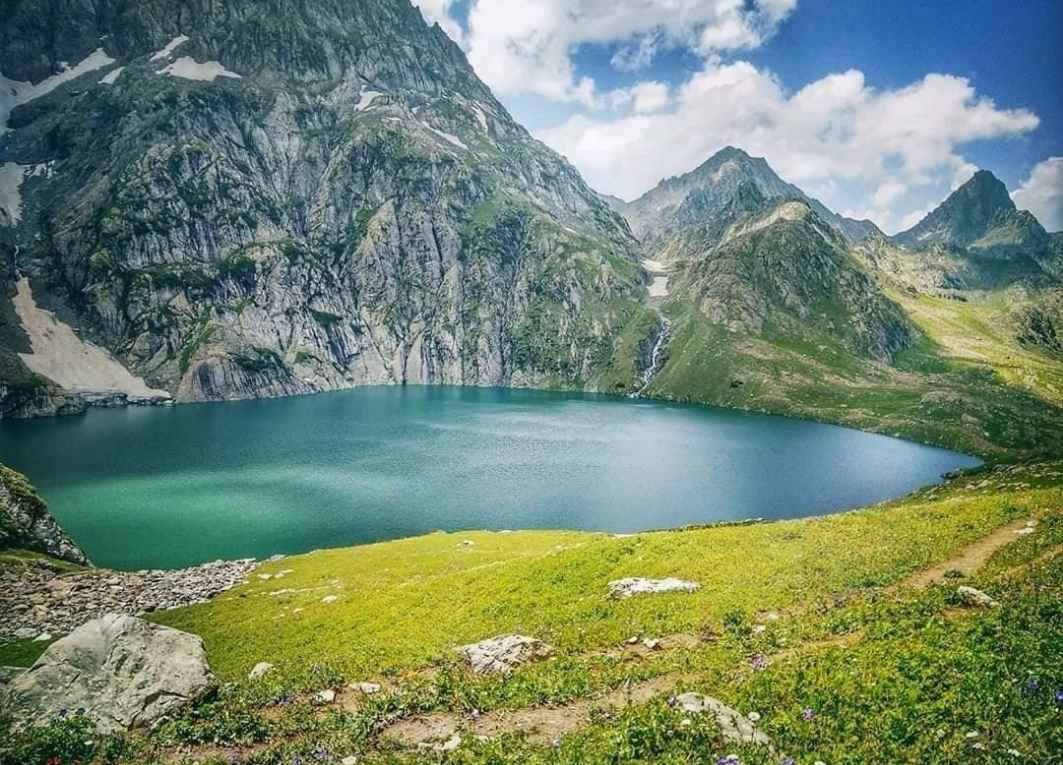
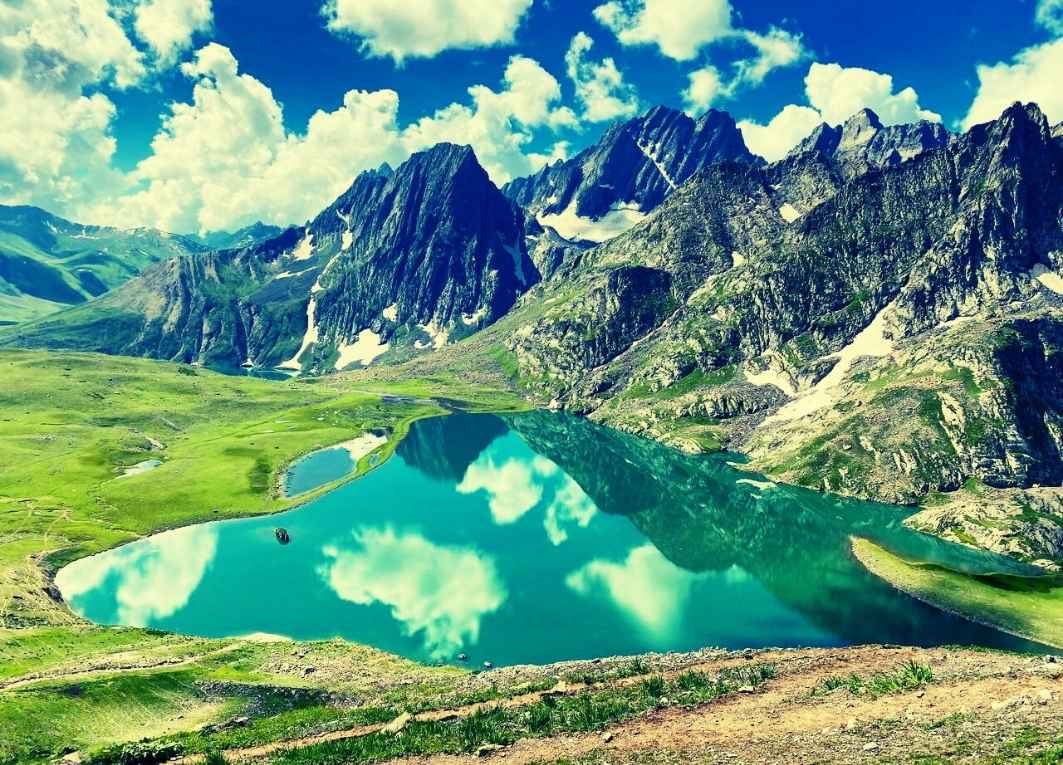
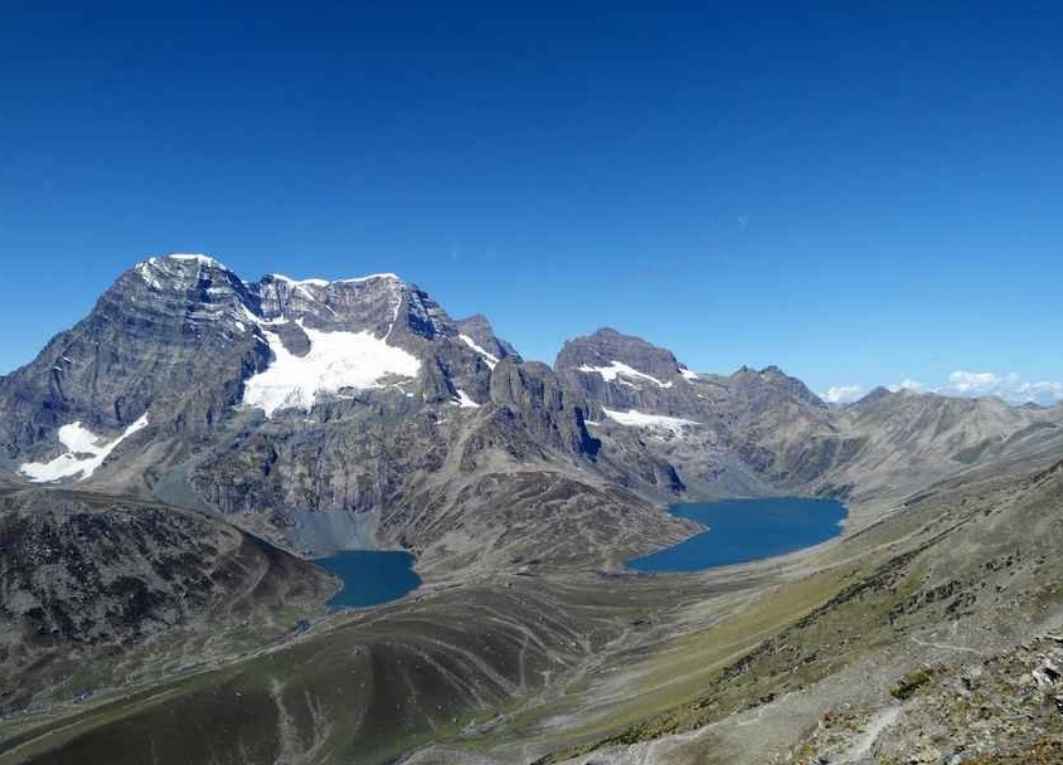
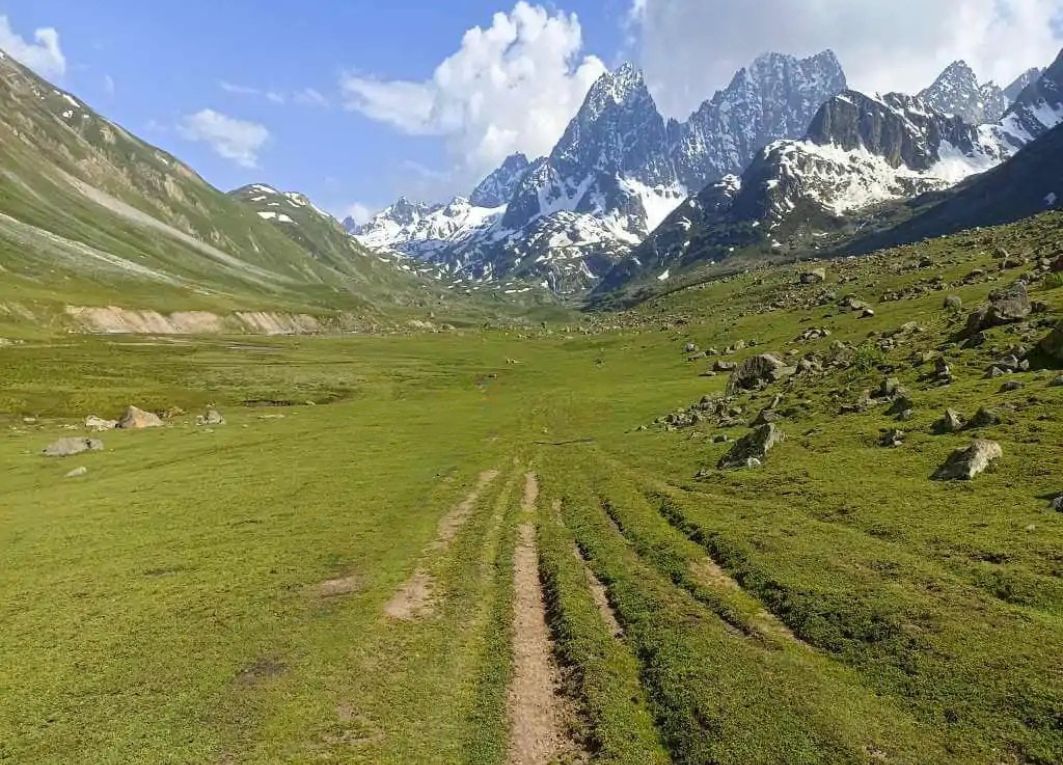
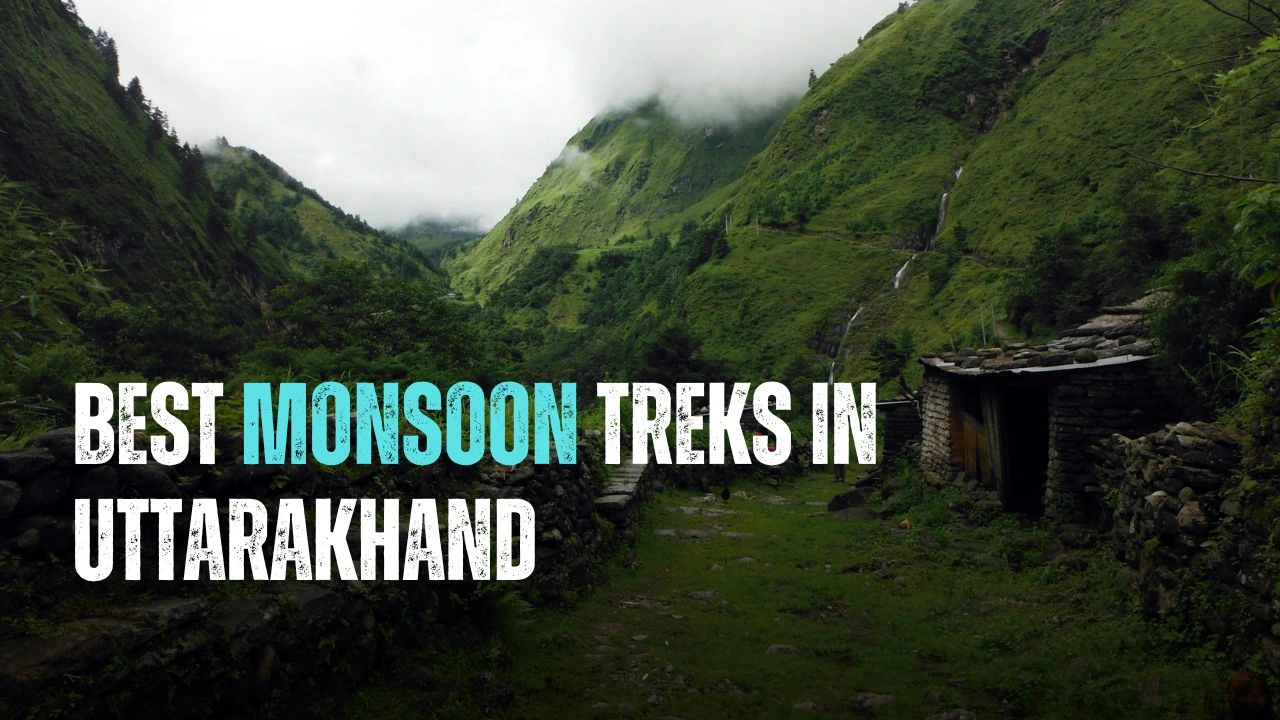

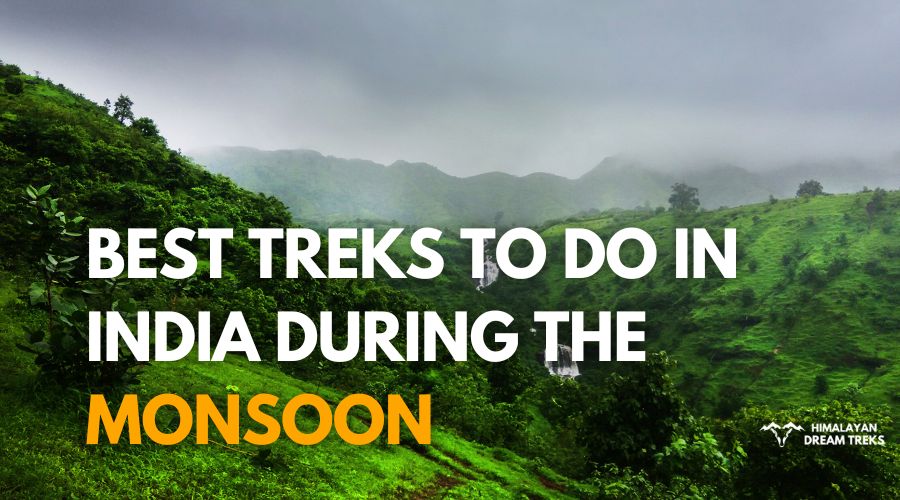
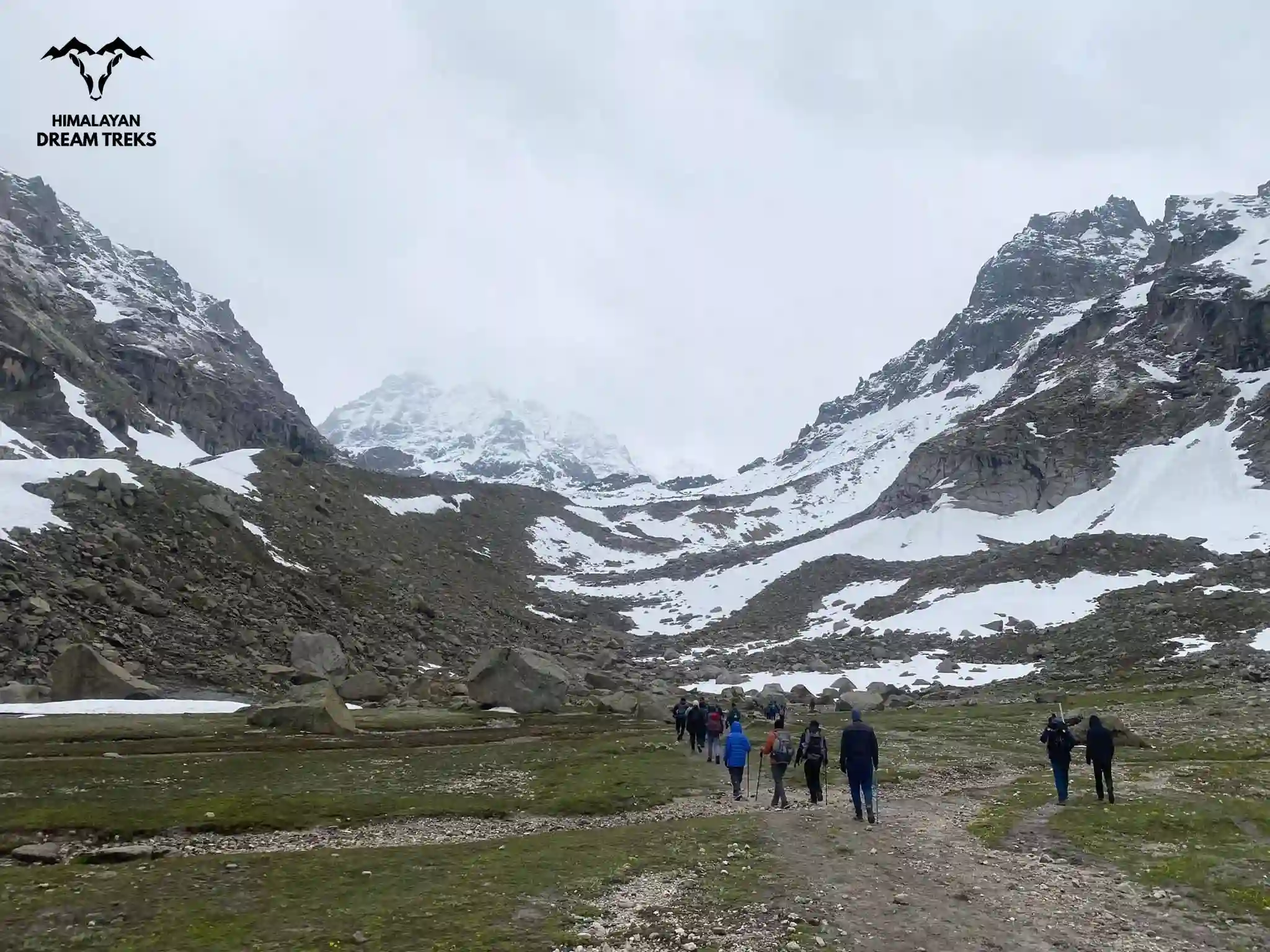
Leave a Comment